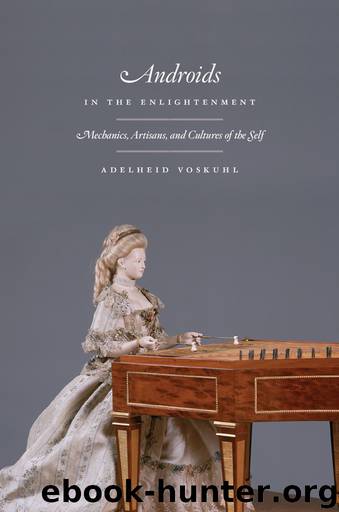Androids in the Enlightenment by Voskuhl Adelheid;

Author:Voskuhl, Adelheid; [Voskuhl, Adelheid]
Language: eng
Format: epub
Publisher: University of Chicago Press
Published: 2013-03-14T16:00:00+00:00
SIX
The “Enlightenment Automaton” in the Modern Industrial Age
In this final chapter, I follow the path taken by the figure of the “Enlightenment automaton” in the nineteenth and twentieth centuries. The journey demonstrates how versatile the figure was and traces how the automaton became a symbol of human-machine relations in the industrial age. I outline broad developments, such as the formation of historical and literary disciplines and engineering education in the Second Industrial Revolution, and I also look in detail at individual texts, such as passages from Marx’s Capital, Thomas Carlyle’s “Signs of the Times,” and Norbert Wiener’s Cybernetics, to bring out nuances in the struggle over the cultural significance of the automaton. This history and these texts, taken together, help explain the origin of current conceptions of Enlightenment automata (such as the flawed ideas discussed in chapter 1) and why they have proved desirable and useful despite the considerable historical and conceptual contradictions between these ideas and the findings of my study. This chapter’s journey also amounts to a short history of the industrial age itself, viewed through the lens of the Enlightenment automaton.1
The android automata made between the 1730s and the 1780s—the two that I have focused on and the others that I reviewed in chapter 1—attracted the attention of many influential commentators in later years. Already beginning in the 1790s, important texts used details of the androids for purposes of entertainment and education. Among these texts were technical encyclopedias, engineering textbooks, histories of technology and invention, and manuals for clock-making and other mechanical arts.2 Such texts were produced in increasing numbers at the time as a result of school reforms, increasing literacy, and changing cultural and economic functions of reading. Interest in technological education came with the Enlightenment’s general commitment to education in the “useful” sciences, as well as with a growing middle class that could afford to buy and read books and was interested in institutional learning.
The production of educational technological literature continued during the nineteenth century’s Industrial Revolution in Britain and on the European continent. Scholars and state administrators added technology to university curricula, and there was increasing demand for reading material for the educated classes and for newly founded polytechnic educational institutions.3 The texts produced to fill these needs proved influential not least because their authors wrote and published widely and prolifically and were often interested in larger social and political issues. The references in these texts to eighteenth-century automata as illustrations and examples kept their images and names alive throughout the nineteenth century.
Close connections in this literature between technology, pedagogy, economics, and natural sciences were typical, and they allowed the automaton motif to travel between genres and audiences. A prominent example is the works of Johann Heinrich Moritz Poppe, an engineer, mathematician, educator, and historian of technology. The son and apprentice of a university mechanic of the University of Göttingen, Poppe studied mathematics, physics, and state sciences (cameralism) in the 1790s under eminent teachers such as Georg Christoph Lichtenberg and Johann Beckmann. He wrote
Download
This site does not store any files on its server. We only index and link to content provided by other sites. Please contact the content providers to delete copyright contents if any and email us, we'll remove relevant links or contents immediately.
Whiskies Galore by Ian Buxton(41860)
Introduction to Aircraft Design (Cambridge Aerospace Series) by John P. Fielding(33064)
Small Unmanned Fixed-wing Aircraft Design by Andrew J. Keane Andras Sobester James P. Scanlan & András Sóbester & James P. Scanlan(32743)
Craft Beer for the Homebrewer by Michael Agnew(18139)
Turbulence by E. J. Noyes(7933)
The Complete Stick Figure Physics Tutorials by Allen Sarah(7306)
Kaplan MCAT General Chemistry Review by Kaplan(6865)
The Thirst by Nesbo Jo(6824)
Bad Blood by John Carreyrou(6540)
Modelling of Convective Heat and Mass Transfer in Rotating Flows by Igor V. Shevchuk(6390)
Learning SQL by Alan Beaulieu(6207)
Weapons of Math Destruction by Cathy O'Neil(6135)
Man-made Catastrophes and Risk Information Concealment by Dmitry Chernov & Didier Sornette(5920)
Digital Minimalism by Cal Newport;(5661)
Life 3.0: Being Human in the Age of Artificial Intelligence by Tegmark Max(5472)
iGen by Jean M. Twenge(5365)
Secrets of Antigravity Propulsion: Tesla, UFOs, and Classified Aerospace Technology by Ph.D. Paul A. Laviolette(5309)
Design of Trajectory Optimization Approach for Space Maneuver Vehicle Skip Entry Problems by Runqi Chai & Al Savvaris & Antonios Tsourdos & Senchun Chai(5011)
Electronic Devices & Circuits by Jacob Millman & Christos C. Halkias(4905)
